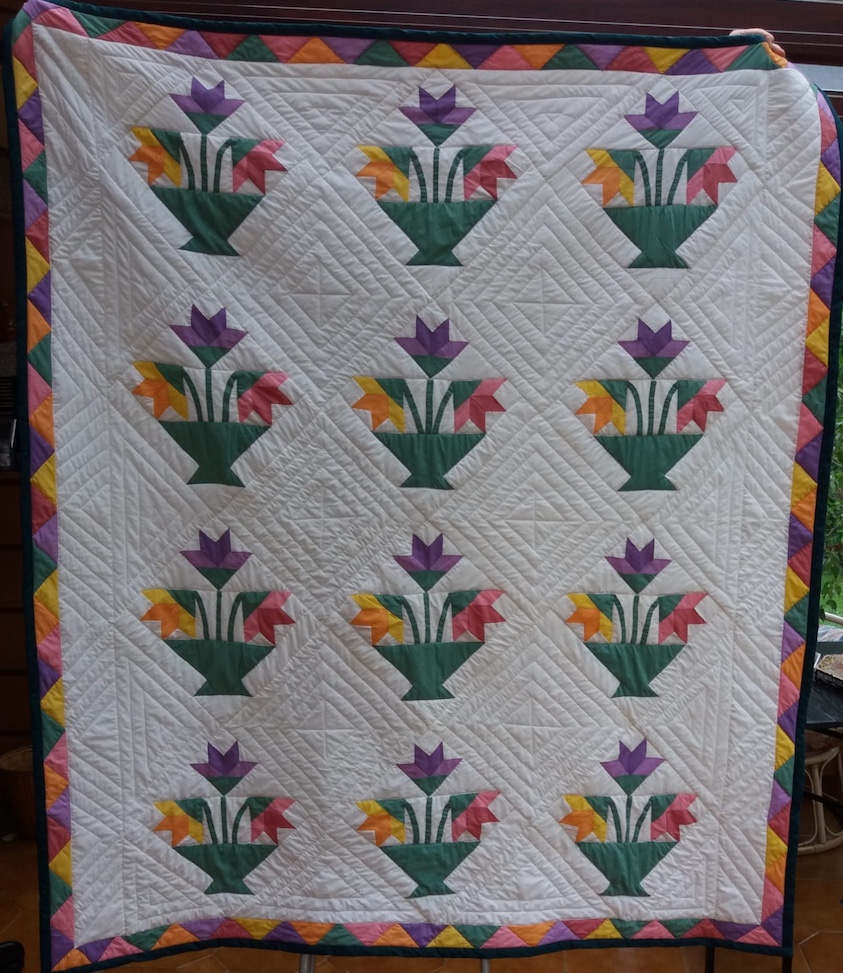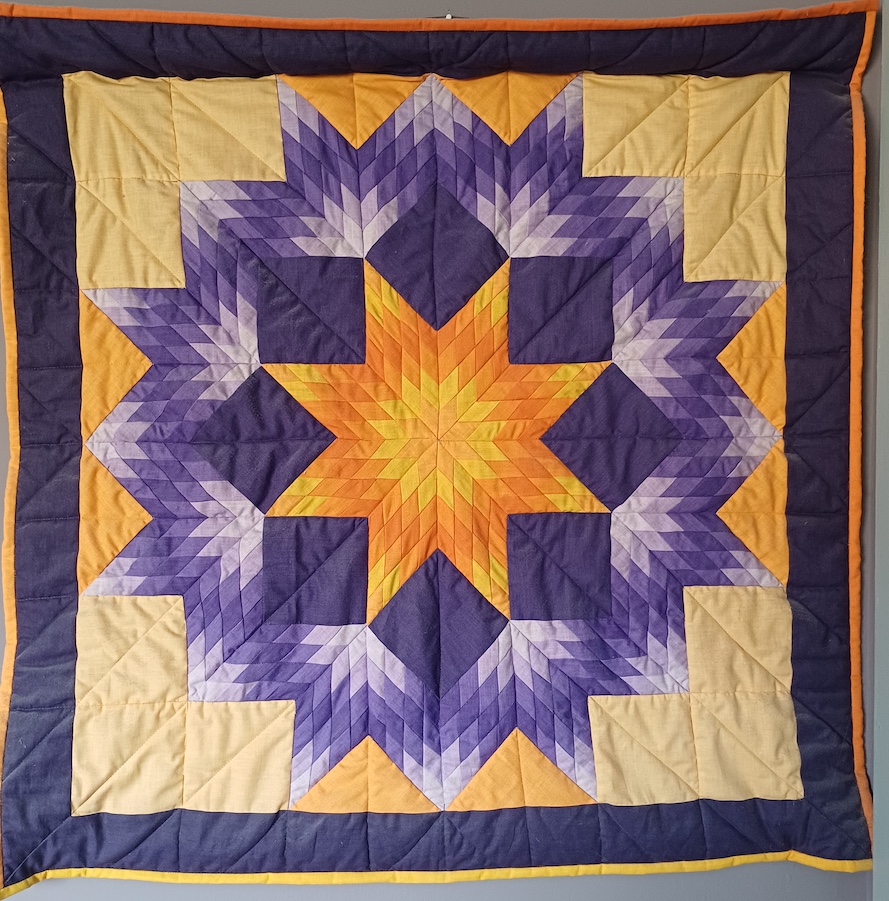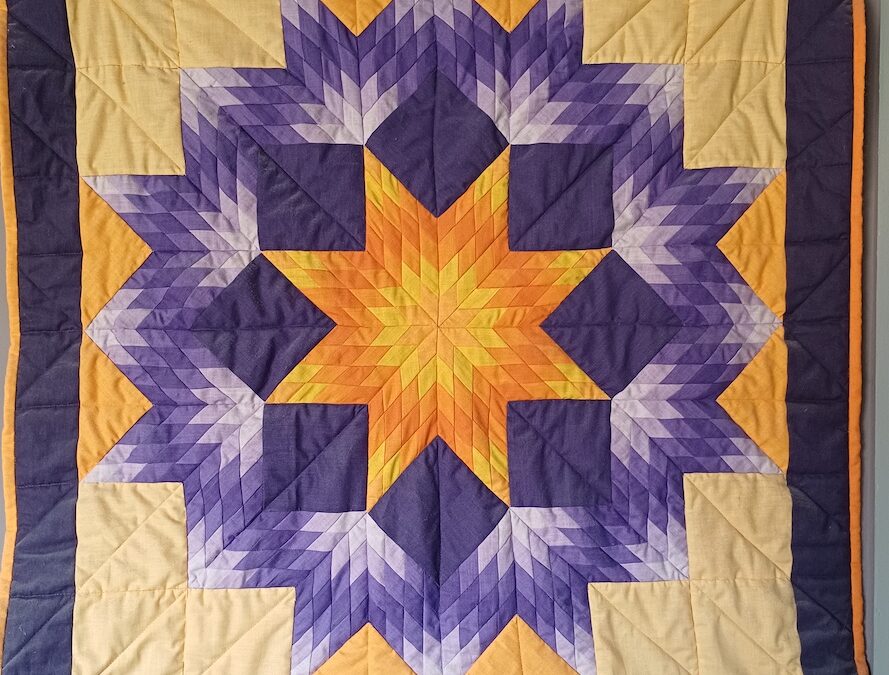This has been an extraordinary week of firsts for me, and one I’m very proud of. The launch of the Wheway Yarns website, the arrival of freshly minted business cards with Textile Artist printed proudly beneath my name, and the presentation of a hugely successful collaboration with @YAP Ireland at their national event in Croke Park all feel like entirely new experiences.
And yet, when I think about it, embracing a creative identity rooted in textile art is actually four generations in the making – so perhaps not new at all. I grew up in a house brimming with handcrafted pieces, both practical and decorative. My mother made most of our clothes until I was old enough to demand “cooler” shop-bought ones. I can barely remember seeing her watch television without knitting needles clicking away in her hands. Our walls were adorned with cross-stitch, patchwork quilts, and delicate paper cuts (the latter courtesy of my aunt; the only family member who embraced her talent and made a commercial success of it).
If asked, my mother would never call herself “creative” only “practical.” She insisted she was “simply following a pattern,” as if anyone who could read could also sew a Debs dress, quilt a wall hanging, or knit an Aran sweater.
In 2020, when time was plentiful and activities limited, Mom resurrected a work-in-progress quilt she had inherited when her own mother died in 2001. That quilt had already lived a long, unfinished life; begun by my great-grandmother around 1960, continued by my grandmother, and then set aside for decades. Mom took it in hand, completed the remaining patchwork, added the backing, quilted the bedspread, and finished the edging.

The photo above, taken in 2021, shows the stunning result – somehow fresh and contemporary despite being 70 years and three generations in the making. I was awed by this creative lineage: women whose artistry had been quietly diminished by a time that labeled their work “craft” instead of “art.” I also felt a pang of sadness, certain the tradition would end with them, as I had no real skill with a sewing machine and had never considered patchwork or quilting a hobby.
Imagine my surprise, five years later, to realise I have found my own way into textile art, just by a different route. I may not quilt or sew, but I knit and crochet. Occasionally, I embroider onto crocheted pieces or use yarncraft to create works that visualise data or commemorate individual lives. My textiles are often less practical than those of my foremothers, but we share the same foundation: a love of making.
As this week of firsts comes to a close, I want to pause and acknowledge the creative lineage that nurtured my talent long before I recognised it as such. I see the same spark in branches of our family tree in many different forms, and I’m only sorry that the remarkable women who came before me weren’t fully recognised as the true artists they were.
There’s another essay waiting to be written about how women’s creativity was historically relegated to “craft” while men’s work was elevated to “art.” But today, I just want to share something personal – and say a belated, heartfelt thank you to my mother, grandmother, and great-grandmothers (one a quilter, one a writer) for the gift I inherited and the care they gave to help it grow.

P.S. This gorgeous quilted wall hanging was a wedding gift from my mother in 2002, titled The Colours of the Day. I love that its palette perfectly matches my new business card, even though my designer @fierceconsulting had never seen it.


I’m so happy to see this new blog! Thank you, Carol!
Thank you Catherine, it’s been many years since I had a regular blog but I’m brimming with ideas for this one so hopefully this is one of many more!
Wishing you the best in this new chapter i can sense the joy, read the giddiness of this new first and feel a sense of belonging across time and generation, firmly claiming your place. Finally, finding your space!!!!!
Thank you Cristina, now that I’ve claimed the space, I intend to keep filling it with more content, creativity, curiosity and conversation so thank you for kick starting that too!
What a tour de force this work is. Not only have you inherited the familial gene of textile artistry, you writing is also beautiful – the tone is intimate, authentic, fuelled by passion. The way you represent data is illuminating – in all senses. And I’m particularly taken by your sensitivity to those women’s voices down the years that have been overlooked or simply regarded as unimportant – if, in fact, they were regarded at all. There is a wonderful book called ‘Threads of Life’ by a Scottish writer, Clare Hunter. You may already know it. I met Clare at a festival in Italy and was enthralled by her exploration of all that sewing represents. https://www.dubraybooks.ie/product/threads-of-life-pb-9781473687936 She spoke about its healing power and the way it was used to help returning soldiers after combat. All those shell shocked men after WW1 who had lost the power of speech due to trauma, who trembled uncontrollably and who were otherwise unreachable: teaching them embroidery was used to help them express themselves, to calm them, and to aid them towards recovery. The work they produced is, I believe, still on display in Scotland. Clare also detailed the ways in which the craft of sewing was gradually overtaken by men in the mediaeval Catholic Church. The richness of the embroidery on bishops’/popes’ vestments spoke to all who encountered them of power: and power belonged definitively to men, so women were relegated to the more ‘practical’ uses of sewing, and the men took over the artistic side. You may also remember one of Clare’s stories about how women in the prisoners of war camp in Changi, separated from their husbands who were imprisoned in other locations, communicated with their loved ones by sewing news into patchwork quilts. The unsuspecting prison guards grudgingly agreed to take these meaningless bits of fabric to the men – completely unaware of the powerful stories literally stitched into the fabric. I’ll stop soon, I promise: but your art is such a rich repository of so many experiences and stories that I find it endlessly fascinating. The family quilts you display are magnificent, and your own displays of data are both delightful and startling. You may already know that a festival I help to curate has FIILI as its acronym: The Festival of Italian and Irish Literature in Ireland. We choose FIILI because it is a nod to the Irish word for poets and also to the Italian word that describes the narrative thread that runs through a story ‘filo narrativo’. So many ways that text and textile are related! And I’ll now end with one final thought: I wonder about the gender balance of entirely voluntary boards (i.e. unpaid) – in my experience, they are almost entirely composed of women.
Thank you Catherine for such a thoughtful and positive analysis. Clare’s book was one of my favourite reads this year, along with Esther Rutter’s This Golden Fleece – a Journey through Britain’s Knitted History. Both books deepened my knowledge of the history of textile craft and art through time and some of the really knotty gendered truths that you alluded to as well as some glorious stories of heritage, family, connection and art. I have a further wish list of reading around the topics of textile art and women so there will definitely be more blog posts on this topic to come! In the meantime, I’ll be excited to check out FIILI in late September.
What a wonderful story that spans generations. Not only are you a creative, textile artist but also a fabulous storyteller too! I really enjoyed hearing about the creativity that was handed down.
The pieces are stunning and timeless. Thank you for sharing.
Thank you Vicky for that lovely feedback. Here’s hoping the four seasons blanket you have will be handed on as a timeless piece in the future!